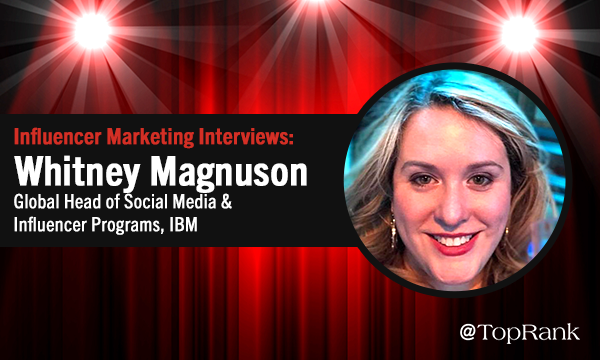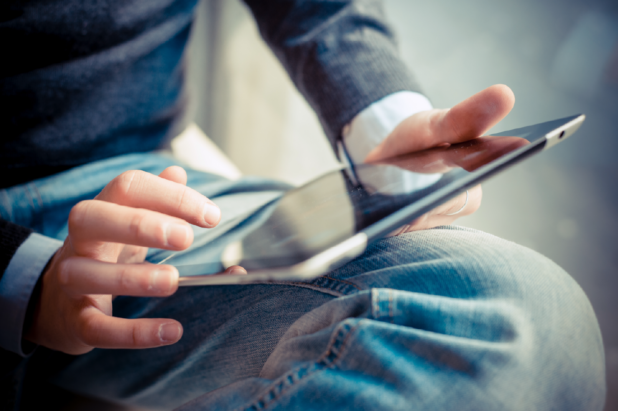
Our journey into the world of B2B influencer marketing continues this week with an interview featuring Whitney Magnuson, Global head of social and influencers at IBM Systems.
Overall, IBM has a long history working with influencers ranging from the Midsize Insider blogging program to the IBM Futurists. For her part at IBM Systems, Whitney has overseen the creation of a first-of-its-kind external influencer outreach program that has since become the model for IBM company-wide among many other accomplishments.
In this interview, Whitney talks about the differences between B2C and B2B influencer marketing, how influencer marketing is positioned within her company, a favorite influencer marketing campaign and tips on tools and measurement.
What brought you to the world of Influencer Marketing?
Early in my career at Google, I had the opportunity to create and lead a program that is now known as Google Local Guides, which is a program within Google Maps dedicated to encouraging user-submitted reviews of local businesses. There we lived and died by the 1-9-90 rule: 1% of users will create content, 9% of users will interact with content, and 90% of users are entirely passive, purely reading the content of others.
As such, we built that program like an early influencer marketing program, before “influencer marketing” really became part of the lexicon. It was all about finding our super users, nurturing them, and keeping them engaged as loyal advocates. The lessons I learned there helped to propel me into my role at IBM, where I was challenged right away to create my business unit’s first dedicated external social influencer program, as well as creating an internal social advocacy program for IBM employees. Those programs are both now quite mature and doing great things for our business.
How is influencer marketing different for B2B than B2C?
Obviously, B2C influencer marketing has kind of exploded over the past couple years, especially on Instagram and YouTube, with every person with an account seemingly hawking some company’s products. But in the B2B area, we have to be a lot more strategic, and so it’s all about quality over quantity.
Especially in Tech, you see a lot of skepticism among developer and engineer types when they’re approached with anything that even remotely resembles an ad. So we take a lot of care in selecting who we want to partner with and what those partnership will look like, to make sure it feels natural to both our brand and the influencer’s existing audience.
Partnering with an influencer allows you to highlight your brand’s own existing narrative in a new way, so that you can reinforce the proof points you really want your customers to know. @whitneymagnuson @IBMSystems
What are 2-3 of the main benefits of collaborating with influencers for B2B companies?
Year over year, we’ve seen consumer trust of brands decreasing, and people turning to seemingly more objective sources when making buying decisions: peers, 3rd party review sites, analysts, etc. Partnering with an influencer allows you to highlight your brand’s own existing narrative in a new way, so that you can reinforce the proof points you really want your customers to know.
How is influencer marketing positioned within your company? Ex: independent department that serves the brand and departments / business unites or is it more decentralized? What are the advantages of that structure?
I have a 3 person “digital relationships team” that reports into me alongside the rest of our social media and content team members. That team oversees our external influencer program, our internal employee advocacy program, and our developer relations strategy. And while those can seem like very different audiences, grouping these three things together works for us, because at their heart they all focus around creating and nurturing long-term relationships.
It’s only after we’ve engaged with an influencer and have really gotten to know them that we would ever approach them about working together on a specific project. @whitneymagnuson @IBMSystems
What tips can you share about being more effective about influencer identification, qualification and recruitment?
Our motto is to give 10x before you take. So when we first identify an influencer that we’re interested in working with, we don’t immediately go in with an ask. Instead, we begin following and engaging with an influencer’s existing content, inviting them to special “behind the scenes” activities, giving them access to our top executives and subject-matter experts when possible, etc. It’s only after we’ve engaged with an influencer in this way for at least six months and have really gotten to know them that we would ever approach them about working together on a specific project.
Do you have a favorite B2B influencer marketing campaign that you can share? What made it successful?
I really liked the outdoor activation we did at this year’s IBM Think conference. For this campaign, we brought influencers in to a video booth we had set up on-site at the event, and asked them a series of questions. The influencers thought we were creating content for a video series (and we were) but we were also able to leverage the footage to showcase these influencers on a giant billboard right in the middle of the Las Vegas Strip, where the event was held.
So not only did we get to film some very interesting conversations with our influencers and turn that into video content, but we were able to give them a larger-than-life surprise-and-delight moment that they all loved. One of the influencers that participated still has the photo of her billboard pinned as the top Tweet on her Twitter feed, nine months later.
Instead of impressions or reach, we’re looking at engagement, click-throughs and the quality of responses when we work with influencers. @whitneymagnuson @IBMSystems
What advice can you share about measuring success with influencer marketing?
In the past year, we’ve made a concentrated effort to look at quality over quantity. So instead of impressions or followership or reach, we’re looking at engagement, and click-throughs and the quality of responses coming in when we work with influencers. And I think, as we saw so many fake influencers unmasked during the “Great Twitter Bot Purge of 2018,” a lot of companies are seeing the value in moving to that sort of a strategy.
Speaking of technologies, any favorite tools or platforms you can share?
We use Onalytica for influencer identification and relationship management. It allows us to visualize how an influencer is connected to the folks in his/her network or around a given topic or hashtag. That way we know we’re reaching the right audience with an influencer, instead of being swayed by his/her followership numbers or sales pitch.
Influencers that are going to survive are going to need to become data savvy in order to prove their worth to the companies interested in partnering. @whitneymagnuson @IBMSystems
How do you think influencer marketing will have evolved in the next year or two? What will it look like in 2020?
People are starting to get burned out with influencers on the B2C side — consumers aren’t as impressed by it, and marketers are tired of dealing with entitled influencers requesting free products. So I think we’ll likely see a contraction of influencer usage, at least on the B2C side. As a response, the influencers that are going to survive are going to need to become data savvy in order to prove their worth to the companies interested in partnering.
Thank you Whitney!
If you would like to learn about what actually works in B2B influencer marketing, be sure to check out our panel this week at the San Francisco Marriott MarquisNovember 15th from 11:15am-12:00pm during the MarketingProfs B2B Forum featuring Amisha Gandhi from SAP Ariba, Dr Konstanze Alex from Dell, and Luciana Moran from Dun & Bradstreet.
Here are the details:

The Confluence Equation: How Content & Influencers Drive B2B Marketing Success
Content and influencer marketing are hot topics for B2B marketers all over the world as two of the most promising strategies for attracting, engaging and converting ideal customers. What many marketers don’t realize is how collaborating with influencers can create even more credible, relevant, and optimized experiences for target accounts. Join moderator Lee Odden and an expert panel of B2B brand influencer marketing executives from SAP Ariba, Dell, and Dun & Bradstreet to learn how working with influencers and their communities can help scale quality B2B content that gets results. You’ll learn:
- The variety of benefits from B2B influencer collaboration
- How major B2B brands plan, implement and measure influencer content
- About processes and technologies that support influencer marketing success
We hope to see you there!
Be sure to check out the other interviews in this B2B Influencer Marketing Series:
- Rani Mani – Head of Social Influencer Enablement at Adobe
- Martin Jones, Senior Marketing Manager for Cox Business at Cox Communications
- Angela Lipscomb – Influencer Relations Manager at SAS
- Amisha Gandhi – Vice President of Influencer Marketing at SAP Ariba
- Lucy Moran – Senior Vice President of Digital, Content & Creative at Dun & Bradstreet
- Dr. Konstanze Alex – Head of Corporate Influencer Relations at Dell


